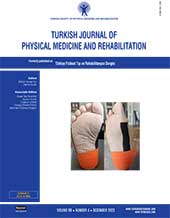Assessment of isokinetic hip muscle strength and predictors in patients with lower limb amputation: A cross-sectional study
2 Department of Physical Medicine and Rehabilitation, Gaziler Physical Therapy and Rehabilitation Training and Research Hospital, Ankara, Türkiye
3 Department of Orthopedics and Traumatology, Health Sciences University, Gülhane Training and Research Hospital, Ankara, Türkiye
4 Department of Physical Medicine and Rehabilitation, Gülhane Medical School, Health Sciences University, Ankara, Türkiye DOI : 10.5606/tftrd.2023.13098 Objectives: The purpose of the study was to determine isokinetic features and analyze significant predictors related to activity level of patients with lower limb amputation.
Patients and methods: Forty-three male patients (mean age: 32.9±8.8 years; range, 21 to 50 years) with lower limb amputation were recruited consecutively for this cross-sectional study between March 1, 2022, and June 30, 2022. The hip flexor and extensor peak torques and total work were evaluated by an isokinetic dynamometer. The secondary outcome measure was the Amputee Mobility Predictor. A linear regression analysis was used to determine factors independently affecting Amputee Mobility Predictor scores.
Results: All data of patients with unilateral amputation, except for flexor (p=0.285) and extensor (p=0.247) peak torques on the dominant side, were higher than those of patients with amputation. Dominant side extensor peak torque was statistically higher than nondominant side extensor peak torque (59.4±30.7 vs. 43.4±32.0) in patients with bilateral amputation. No difference was detected between amputated and intact sides of patients with unilateral amputation. Both flexor and extensor total work on the amputated side of the patients with below-knee amputation were higher than the patients with above-knee amputations (63.5±21.1 vs. 94.1±34.3 and 67.1±34.0 vs. 113.0±51.5, respectively). Unilateral amputation (odds ratio: 7.442) and nondominant side extensor total work (odds ratio: 0.615) were found to be significant predictors related with amputee mobility predictor scale.
Conclusion: It is possible to have an idea about the possible activity level of the patients with lower limb amputation with the help of the predictors obtained in the current study.
Keywords : Amputation, amputee mobility predictor, gait, isokinetic, mobility, strength
















